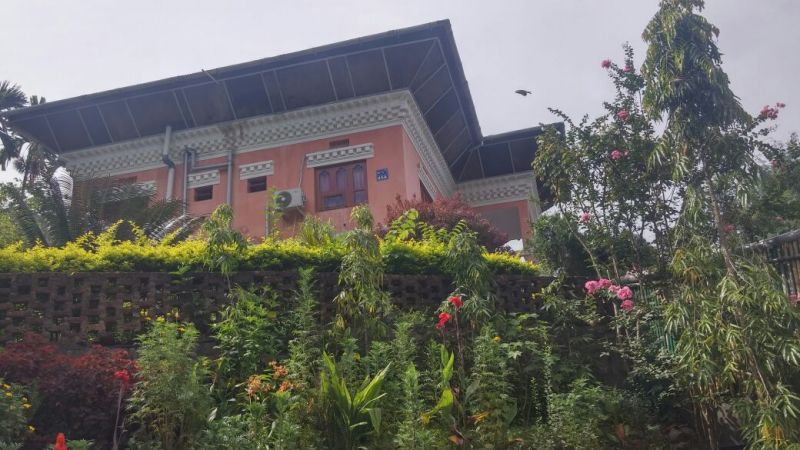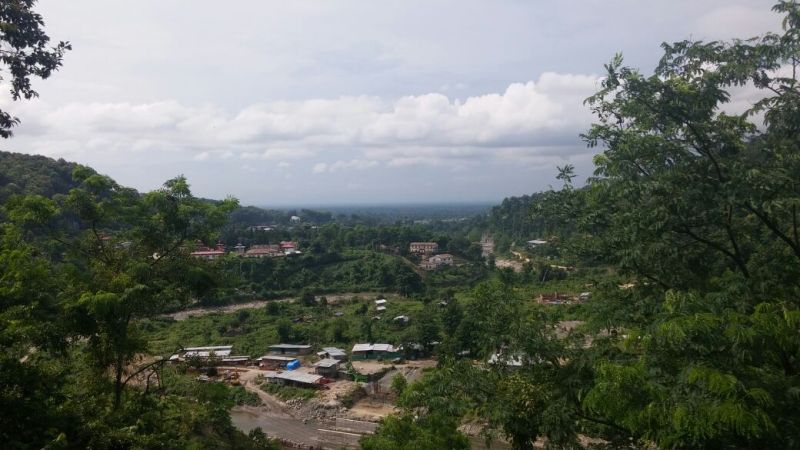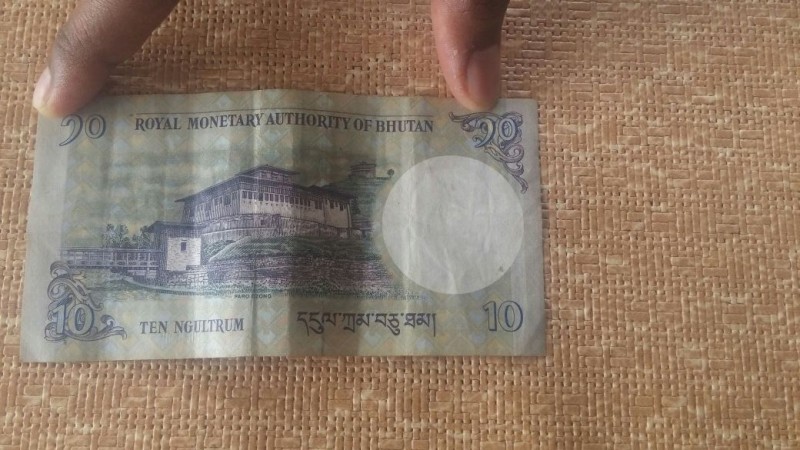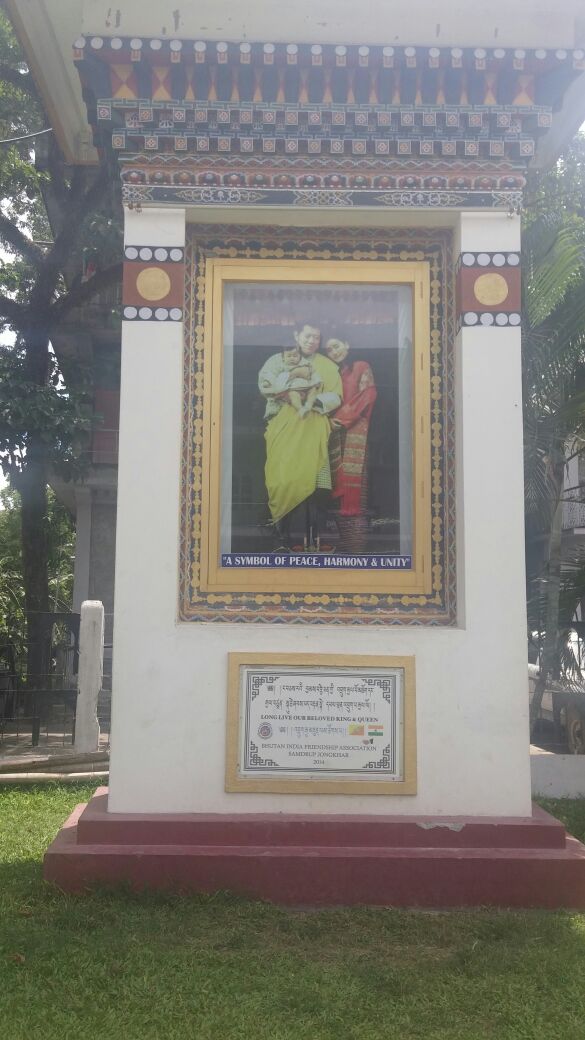Finding that we had only a limited number of weekends, the six of us resolved to make the most of whatever time we had. Taking almost the whole of our first week to adjust and chalk out the plan for the weekend, we decided to explore Meghalaya and its gorgeous destinations. We were disheartened to find that our plan was made a bit too late – we ran out of hotels to stay in. Considering the suggestion of our new colleagues, we zeroed down on an impromptu trip to Bhutan instead. We wondered though if an international was possible, considering that half the group didn’t have our travel documents (Voter ID card or passport). A senior in the office came to our rescue. He mentioned about the tiny bordering town of Samdrup Jongkhar, and how one could enter through the first gate and explore a speck of what our happy neighbour had to offer.
Being overly excited about the first international trip (sans family) we woke up at 4 am and aimed to leave the guest house by quarter past five. Expecting to be greeted by a pitch-dark sky, we were pleasantly surprised to be welcomed by a bright morning. At 4 am. Despite all our efforts to leave early we ended up leaving only a little before six. We passed by IIT Guwahati en route to the tiny town of Rangia. The trip was just perfect for us – Samdrup Jongkhar is only about 110km away from Guwahati, and we estimated to cover the distance in a little less than two hours. To cure the sleepiness and add a zing to the morning my roomie started playing the latest peppy songs with a good tempo. The splendid morning scenery and the lush greenery helped greatly as well, and the butter-smooth roads only added to the comfort of our journey.
We passed by acres of rice fields and tea plantations on the way. The funniest part of our journey was to see the cattle laze on the road – be it cows, buffaloes or goats – they walked and sat right in the middle of the two-lane road without a care in the world. We took the Rangia-Daranga Road, which took us to Samdrup Jongkhar in less than forty-five minutes. Once there, we were asked to alight and cross the border on foot.
It took us less than a minute to fall in love with the Bhutanese architecture. Even though the design of the buildings was pretty simple, it was very elegant – it appeared as though even the buildings seemed happy! We passed by a few prayer flag installations on the way to the restaurant. After a quick photo session, we proceeded to go for breakfast at one of the nearby restaurants called the Tashi Gasel Lodge.



I was awestruck by the location – in addition to being a great sight itself, the place offered amazing views of the surrounding hills. We were slightly disappointed with the breakfast options available – even though the menu was expansive, all they had to offer on that day was masala omelet, sweet bread and fried rice. Finishing our breakfast as quickly as we could we proceeded to the next agenda on the list – sightseeing.
The first place we visited first was Samdrup Jongkhar Dzong. A Dzong is a fortified building with towering exterior walls surrounding a complex of courtyards, temples, monasteries and administrative offices. The Samdrup Dzong serves as the town’s administrative and judicial centre.
The intricate design on the outside and the perfectly manicured lawns really wowed us. The most interesting thing about the Dzong is that it is the newest and is made of cement, unlike other Dzongs which are made of brick or stone. Moreover, the Dzong at Samdrup is built on a flat-land, unlike the others which are usually situated on strategic cliffs or vantage points.
Soon after our brief visit to the Dzong, we went to the Rabdey Dratshang, which is the place where the monastic community of Samdrup Jongkhar resides. The monastery was inaugurated in 2004. We were mesmerised by the beauty of the monastery – right from the main entrance to the prayer hall and the houses behind, the art was very tasteful.
I personally loved how the monastery exuded a sense of peace and calmness. Even though the weather outside was hot, the temperature in the monastery premises was pleasantly cool. We stayed there for a while absorbing its serenity, and after clicking a few photos we moved to the final part of our limited Bhutan experience – the local market.
The local market, Mella Bazaar, was the place we had been really excited to visit and shop for souvenirs. An interesting observation I made at the bazaar was that unlike their Indian counterparts the shops had really simple-looking name boards – the boards were dark (most of them either navy blue or black) and had the details written on them in white paint. I was a bit surprised to find out that most of the products in Bhutan were sourced from India – right from the vehicles to consumer products. We noticed that even the ice cream we relished at one of the shops had been produced in Guwahati itself! Among other things, we purchased prayer flags with the Divya Mantra on them – Om Mani Padme Hum. It was only after I read the meaning on Quora that I realized how beautiful the Mantra is –“In dependence on the practice of a path which is an indivisible union of method and wisdom, you can transform your impure body, speech, and mind into the pure exalted body, speech, and mind of the Buddha.”


Refreshed, enthralled and enchanted we resumed our journey back to our side of the border. The entire experience had taken us a little more than three hours and gave us bragging rights such as having crossed an international border on foot (without a passport), and going to another country for breakfast.
Here are a few tips and tricks to help in case you are planning a trip to Samdrup Jongkhar in the near future –
- The distance between the Guwahati airport and Samdrup Jongkhar is 110km. On leaving Guwahati early, one can reach Samdrup Jongkhar in a little less than two hours. The roads are pretty good.
- Samdrup Jongkhar is the oldest town in Bhutan. To enter it from Assam one doesn’t need travel documents. However, as an Indian, if you wish to explore more of Bhutan, you would need to carry either the passport or your voter ID card. In the recent days, I have heard of the border authorities also accepting Aadhaar, but I am not sure about how accurate this information is.
- In case you are wondering about the currency conversion between Bhutanese Ngultrum and Indian Rupee, you don’t have to worry much as the exchange rate is 1:1. Indian Rupee is accepted in Bhutan, and Ngultrum is accepted in parts of Assam near the border.
- The route to the border town is replete with greenery and has acres of rice and tea plantations.
- It is essential to carry some food (preferably some dry snacks) along with you for the journey
- Preferably dress conservatively while visiting monasteries – preferably wear long sleeved shirts and full-length trousers. Avoid wearing t-shirts or short skirts. Usually, hats and umbrellas aren’t allowed inside either.
- Please keep your phones in silent mode and talk in a quiet tone while visiting monasteries.
- Photography is usually allowed in the courtyard of most monasteries.
It is customary to give a small donation when visiting a monastery.








